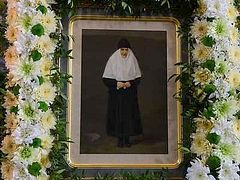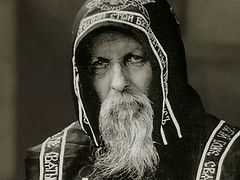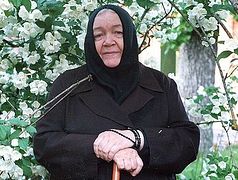August 17, 2020 marked ninety years from the birth of the renowned Abbess Barbara of Holy Dormition-Pukhtitsa Monastery in Estonia.
Last Paschal season [and around Victory Day] I remembered how, forty years ago, at the turn of the 1980s, during Bright Week, the abbess of Pukhtitsa Monastery Mother Barbara (Trophimova) and Mother Georgia (now the abbess of the Gorny Convent in Jerusalem) greeted all of us with Christ’s Pascha: They went around with gifts and praises—singing festal hymns—not only to the sisters in their cells, but also at the homes of the clergy and laity who lived near the monastery. They also had festal gifts for several Estonian families who, although not Orthodox, were particularly friendly to the monastery. And it has remained this way to this day despite all the political changes—Estonians really love our Holy Dormition Monastery.
I remember well how one day in Bright Week Mother Barbara and Mother Georgia came to visit my wife and I with Paschal gifts, with an enormous kulich and an extraordinarily delicious Pukhtitsa Pascha cheese. The first thing we did was sing the Paschal troparion together, then we sat down to tea. There was a guitar in the corner of the room across from where Mother was sitting. Having glanced over at the guitar several times, Mother asked if I would play something for her and Mother Georgia. I got up from the table and picked up the guitar. A little embarrassed, I said I could sing a Paschal verse I had written myself. Mother Barbara and Mother Georgia perked up and with one voice exclaimed: “So you write songs too?” “Yes, in my spare time from Church services,” I said, trying to laugh it off, even more embarrassed, but now there was no turning back.
“’He is risen!’ a wondrous voice joyfully saith,
He is Risen, and has saved us from death…”
I began singing my verse along with the guitar, taking care for my intonation and intently singing the text I hadn’t quite memorized yet. When I finished singing, Mother said to me seriously, without smiling: “Will you give me your word that you’ll sing this song at trapeza for the sisters?” “I will,” I obediently replied. I had barely managed to answer before Mother Barbara reached for the guitar, and I immediately handed it to her. Everyone quieted down, surprised, looking now at the abbess’ face, now at the guitar. Meanwhile, Mother began to tune the guitar, or rather, to retune it from a six-string Spanish style to the Russian seven-string style. I recognized it because I began to learn on the seven-string guitar as a child, starting to retrain for the six-string guitar only in the eighth grade when it became more fashionable, coming from the West, and began to replace our Russian seven-string guitar.
Having finished tuning the guitar, Mother slowly played the first few bars of the famous guitar piece, “The Death of the Titanic,” then said with a smile: “No, it’s not working. I need another string. I learned how to play on a seven-string guitar, and this is a six-string.” At these words, we, the audience, warmly applauded this performer in abbatial dignity, and I jokingly apologized that I didn’t think to get a seven-string guitar for such an occasion. Mother answered my joke with a joke, and then suddenly remembered that she and Mother Georgia still had to take Paschal gifts to other homes.
I accompanied the guests to the gate, went back into the house, grabbed the guitar, and tried to repeat those few bars of the melancholy waltz that Mother Barbara played. Then I remembered the lively story I’d just heard from Mother over tea, about how as a girl, she came from Luga to Vyritsa to Hieroschemamonk Seraphim (Muraviov) (canonized in 2000 as St. Seraphim of Vyritsa), the elder who was already then renowned for his clairvoyance.
 Abbess Barbara (Trophimova) It was just after the war, and the small house where Elder Seraphim lived out his days was thronged with people.
Abbess Barbara (Trophimova) It was just after the war, and the small house where Elder Seraphim lived out his days was thronged with people.
“I realized that these people had very important requests,” Mother said. “Some of them were hoping, through the prayers of Fr. Seraphim, to find out about their missing husbands, fathers, or children; some of them hadn’t yet recovered from their grief after receiving a ‘death notice’ and came for a word of comfort. But,” Mother continued, “I only wanted to look at the Elder and get his blessing, so I felt a little awkward in front of these people. I went up the porch steps and stopped indecisively. Suddenly the door opened and an elderly woman of monastic appearance clearly said: ‘Where is the girl from Luga?’ No one answered. The woman repeated her question, and then everyone stared at me. ‘You must be from Luga?’ a woman standing nearby asked me irritably, and without waiting for an answer, she gave me a little push. ‘Go, the Elder is calling for you.’
“’How did he know I was from Luga? He hadn’t seen me, and I hadn’t told anyone in line about myself,’ I thought as I walked to Fr. Seraphim’s cell. As I entered, I saw a gray-haired elder lying on the bed. He looked tired and pale. Raising his head slightly, he greeted me and asked what I had come to see him about. I embarrassingly answered that I had no special business with him—I just wanted to look at him, the elder. ‘Well, look,’ Fr. Seraphim said and smiled. Then, after waiting a minute, he beckoned me and blessed me with the Sign of the Cross. Looking at me carefully, he said clearly: ‘Now they will feed you, Valya, then you’ll return home. Go outside and you’ll see a large truck. Stop it, and it will take you straight to Luga.’
“That’s what I did,” Mother said, finishing her story. “I just went outside and there was a truck coming with a big load. I stopped it, and a couple of hours later, I was home in Luga.”
“Yes,” I thought, reflecting at that moment on what I had just heard, “such meetings don’t pass without a trace for the soul. This meeting must have pushed the future abbess towards choosing the monastic path. Or perhaps Elder Seraphim predicted something to her about her future monastic path that she simply didn’t mention in her story? It full well could be.”
I must say that after this story from Mother, Fr. Seraphim and ascetics like him, whose lot it was in the difficult war and post-war years to comfort and encourage people, to instill faith in them and to pray for them, sparing no time or effort, remained in my thoughts for a long time. And how could we forget about the spiritual contribution of such ascetics to the Victory? We cannot. And the Church’s memory preserves their names and remembers their labors and podvigs.




